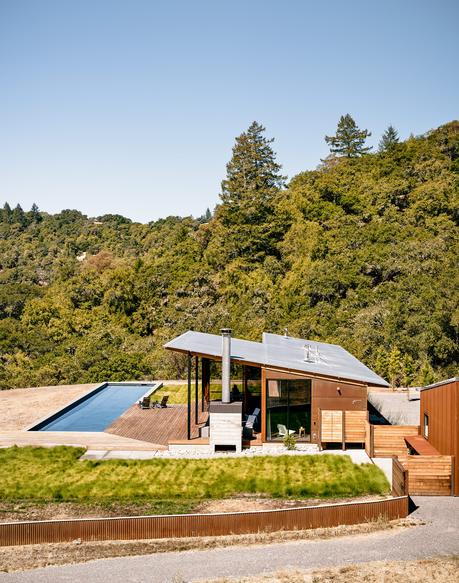
A tradition of weekend hiking trips served as the premise for Jeff and Millie Baird’s off-the-grid retreat in California’s Sonoma County. Affectionately named Camp Baird, the home is located on a 165-acre parcel near a campsite the couple and their two young daughters had visited for years. Architect Malcolm Davis worked with contractors Fairweather & Associates on the new build; landscape architect Cary Bush of Merge Studio incorporated drought-resistant nativeplantings into the property
Project Camp Baird Architect Malcolm Davis Landscape Architect Merge StudioFive years ago, Jeff Baird, a financial investment manager and his wife, Millie, an avid environmentalist, acquired 165 wooded acres in a valley west of Healdsburg, in California’s Sonoma County. They did so largely because their hillside home in Berkeley, designed by San Francisco architect Malcolm Davis, left them desiring outdoor play space for their two daughters, ages 7 and 10. “We really wanted that for them, so we asked Malcolm to design a place focused on the outdoors,” explains Jeff. “We wanted a second home that was not a wine chateau or an urban dwelling.”
While considering its eventual form, the couple began a weekend ritual of hiking along streams or on paths beaten by wild pigs and deer on their hilly new property. Inspired by their time camping under California live oaks, they soon commissioned a tree house as an overlook and a place for repose. When they honed in on a nestled site to construct the new project, their brief to Davis was clear: to build a true off-the-grid campground. “The idea was to enclose as little as possible, and their inspiration came from images of tents pitched on big decks,” says Davis. “They wanted a little more than that, but not a lot more.”
An acolyte of Bay Region Style—a genre famously coined by architecture critic Lewis Mumford to characterize a uniquely humane form of regional California modernism—Davis looked to iconic projects of the past, including Bernard Maybeck’s 1911 open-porch Temple of Wings, and William Wurster’s now-defunct 1938 Greenhill Ranch on Mount Diablo, for ideas. In the end, a nearby dogtrot cabin by Davis’s mentors, William Turnbull and Mary Griffin, who have described it as a “landscape design with occasional rooms in case of rain,” became the clearest model for the new Camp Baird.
Inspired by the sound of nearby water, which “makes the whole site compelling,” says Davis, he devised a design that places a slender, 82-foot-long, solar-heated swimming pool at the heart of the structure. It’s flanked by nearly 1,600 square feet of ipe wood decks on its east and north sides, and two large expanses of grass at the east and west ends—all apt for lounging, playing lawn games, or pitching tents. A board-formed concrete outdoor fireplace used for grilling and cooking, and a partially screened outdoor shower are also situated poolside, providing elegant and convenient, no-frills campground amenities.
Naturalistic drought-resistant native plantings by landscape architect Cary Bush of Merge Studio help soften the surrounding area that is ringed by a 30-inch high, step-over corrugated Cor-Ten fence, which deters unwelcome rattlesnakes. For more effective shelter from the elements—the scorching sun, coastal fog, and rain that frequents the area—Davis devised two rectilinear dogtrot structures. Each one was carefully crafted by Fairweather & Associates from low-maintenance and wildfire-resistant materials: concrete slabs for the flooring; corrugated Cor-Ten steel that blends into the landscape, for exterior cladding; and heat-reflecting, galvanized corrugated metal for the roofs.
Laid in an L–shaped plan on the north side of the pool, the two buildings form an entry courtyard large enough for fire trucks to turn into (a local county requirement). The smaller of the two dogtrot structures—a prefabricated car-and-tool barn with an all-metal frame—doubles as a drive-through portal that extends from the courtyard and into the landscape beyond. The larger dogtrot is a custom cabin with a roof (screwed on to exposed wood-and-steel framing) that contains fully enclosed rooms on a concrete slab floor, covered with wall-to-wall floor coverings by Chilewich and outfitted with a central breezeway.
At each end of the breezeway, swinging doors made of slender ipe wood frames inset with fiberglass mesh screens allow cross-ventilation yet keep bugs out. On the east side of the breezeway are one large room and a half-bathroom; on the west side of the breezeway, the enclosed area contains two smaller rooms, a bathroom and food storage spaces. Intended in part as yoga and exercise spaces, the three main rooms—kept deliberately spare and monastic so tents and sleeping bags can be dragged indoors if the weather turns—have rollaway Fleetwood barn doors that open to the poolside porch outfitted with a commercial-style galley kitchen and dining area.
“We are not connected to the grid at all,” says Jeff, proudly. The non-air-conditioned house is cooled naturally and heated by two wood-burning Rais stoves when the weather gets cold. All other lights, ceiling fans, water heaters, and the kitchen run either on solar power from an array of three stanchions with nine solar panels installed on a distant hill, or from a propane-fueled backup generator.
If there is one thing Jeff still yearns for at Camp Baird, it is Elon Musk’s Tesla Powerwall—a new lithium-ion battery that stores electricity generated from solar panels and is designed for the home. “Nonetheless, I enjoy learning how to make what we have work efficiently,” he says. “Depending on the season, we use timers and dial the pool equipment way back, use little to no irrigation, and raise the refrigerator temperature. We run most of the equipment we need during the afternoon, when we generate the most power.”
Davis, too, understands the rigors—and delights—of living this way. “It is not fully a house because it is a camp with a big shed roof structure and a big porch. The kitchen and main shower are pretty much outside,” he says. “As architects, we stood back and let nature be the star.”
